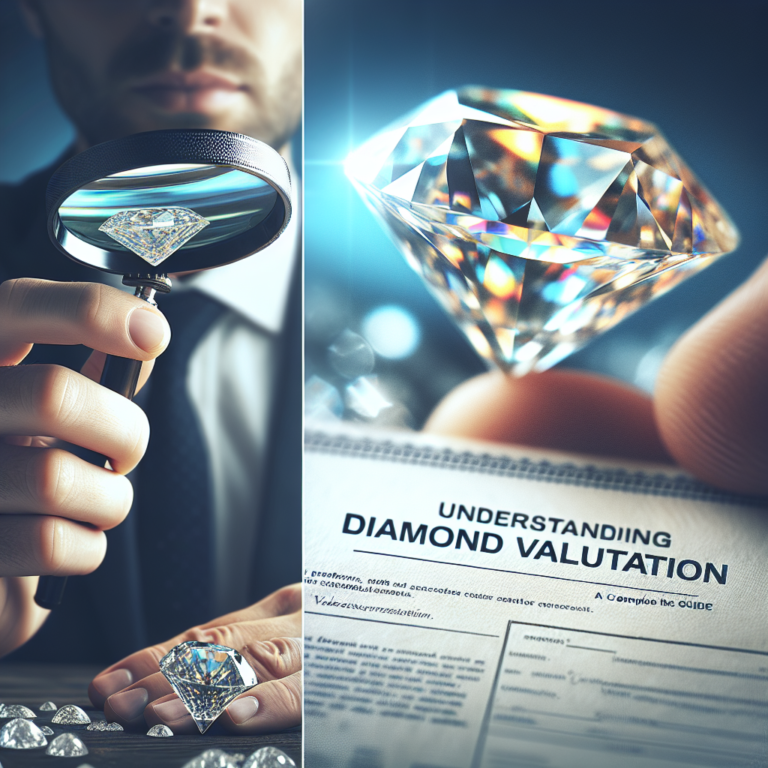Understanding Diamond Valuation: A Complete Guide
Diamonds have long been considered symbols of wealth, love, and prestige. Understanding diamond valuation is essential for anyone looking to invest in or sell these precious stones. This guide will explore the critical factors that affect diamond pricing, current market trends, and practical insights that can help you make informed decisions when it comes to diamond valuation.
What is Diamond Valuation?
Diamond valuation is the process of determining the worth of a diamond based on several factors, including its characteristics, market demand, and overall economic conditions. The valuation process often utilizes the "Four Cs" — Carat, Cut, Color, and Clarity — which serve as the foundation for diamond pricing.
The Four Cs of Diamond Valuation
-
Carat: The carat weight of a diamond signifies its size and is one of the most significant factors in determining its value. According to a recent industry report, diamonds weighing 1 carat or more account for approximately 50% of the total diamond market revenue.
-
Cut: The quality of the diamond’s cut affects how well it reflects light, influencing its brilliance and overall aesthetic appeal. A well-cut diamond can appear more significant than its actual carat weight, elevating its perceived value significantly.
-
Color: Diamonds are graded on a color scale from D (colorless) to Z (light yellow or brown). The demand and rarity of colorless diamonds typically result in higher valuations. In recent years, the market has also seen increased interest in colored diamonds, which can command even higher prices depending on their hue, saturation, and rarity.
- Clarity: Clarity refers to the presence of inclusions or blemishes in a diamond. Higher clarity diamonds (those with fewer imperfections) generally fetch higher prices. According to the Gemological Institute of America (GIA), about 60% of all diamonds fall into the SI (Slightly Included) category.
Current Trends in Diamond Valuation
Rising Popularity of Lab-Grown Diamonds
One notable trend affecting diamond valuation is the rise of lab-grown diamonds. These stones, which are chemically and physically identical to natural diamonds but produced in a laboratory, have begun to impact pricing strategies. As of 2023, lab-grown diamonds now account for nearly 10% of the diamond market, with predictions suggesting this figure could rise in the coming years.
Market Demand and Economic Factors
Current market dynamics heavily influence the valuation of both natural and lab-grown diamonds. The global luxury market has seen a resurgence post-pandemic, leading to increased demand for diamond jewelry. According to a survey by Bain & Company, the global diamond jewelry market is expected to grow by 7% annually, indicating positive long-term trends for diamond valuation.
Making Sense of Diamond Valuation Methods
Understanding the various methods for valuing diamonds can help you gauge whether you are receiving a fair price or providing an accurate appraisal.
Appraisals vs. Market Value
-
Appraisals are subjective evaluations performed by gemologists or certified appraisers who assess a diamond based on its physical properties and the prevailing market trends.
- Market Value, on the other hand, reflects the actual selling price in the current marketplace, which can fluctuate based on demand and availability. Therefore, appraisals can sometimes overstate the value, especially if they are based on out-of-date market information.
Example: Comparing Two Diamonds
Consider two diamonds: Diamond A (1.5 carats, VS2 clarity, G color, Excellent cut) and Diamond B (1.5 carats, SI1 clarity, I color, Very Good cut). Although both diamonds weigh the same, Diamond A could sell for significantly more due to its superior cut and clarity.
Key Factors Influencing Diamond Valuation
- Certification: Diamonds that are certified by reputed grading laboratories tend to have higher valuations as buyers trust these validated assessments.
- Market Trends: Keeping track of current industry trends, such as the growing popularity of sustainable and ethical jewelry, can significantly inform your understanding of diamond valuation.
- Sales Channels: Selling through reputable dealers or marketplaces can influence the final selling price. Diamonds sold through auctions or exclusive stores often command a premium.
Conclusion: The Importance of Knowledge in Diamond Valuation
Navigating the landscape of diamond valuation requires a balanced understanding of various factors that contribute to price. With the rise of lab-grown diamonds and evolving market dynamics, now is a critical time for both buyers and sellers to educate themselves on this intricate valuation process.
For more insights, consider exploring articles on The Diamond Price about effective appraisal techniques or understanding the differences between natural and lab-grown diamonds.
If you are contemplating purchasing or selling a diamond and want assistance in navigating diamond valuation, don’t hesitate to contact us for expert guidance.
Suggested Images
- Image of the Four Cs: Alt Text – "Understanding Diamond Valuation: Four Cs of Diamonds"
- Market Trends Graph: Alt Text – "Current Trends in Diamond Valuation"
By using the insights shared in this guide, you can gain a holistic understanding of diamond valuation, making you better equipped for your investment or sale. Engage with us for future updates and exclusive insights on diamonds.


